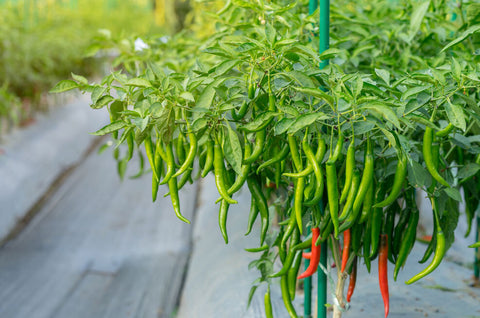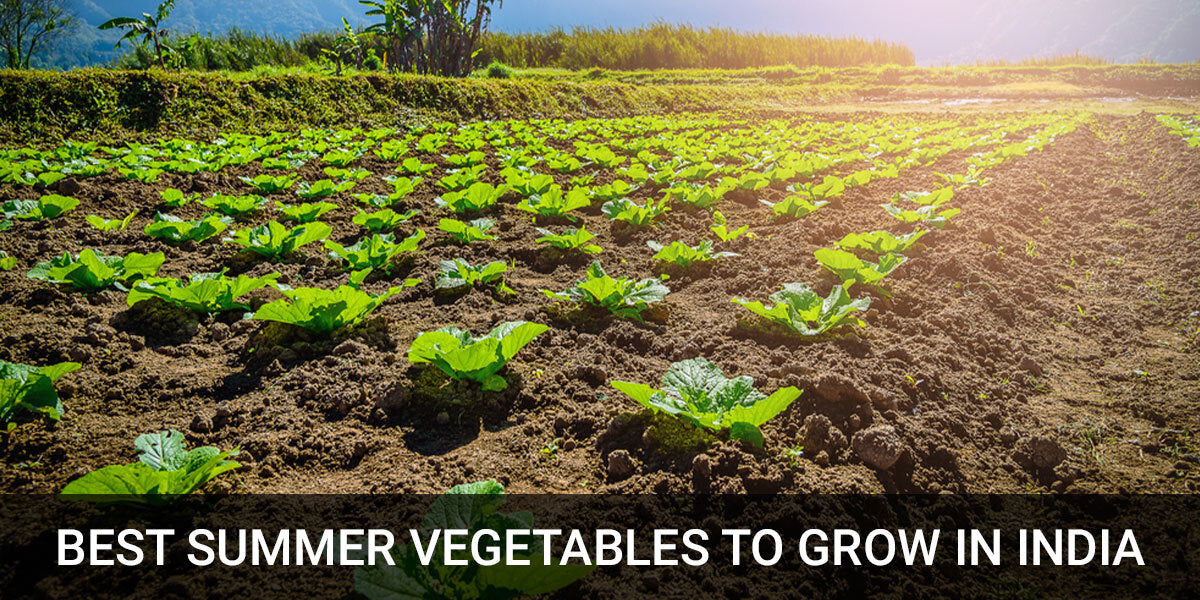How to Grow
13 Best Summer Vegetables to Grow in India
A big shout out to those of you who have taken a short break from all your gardening works due to the foggy weather of winter.
In the spring itself, even plants are awakened from their winter sleep (dormancy) and are actively involved in their growth.
Now is the time for you to come out and take a part in your gardening activities again. Because summer is approaching India.
Summer in India starts in the month of March and continues till May. Days are longer when compared to the nights in the summer.
Just as some vegetables prefer the cooler temperatures of winter and spring, some vegetables prefer maximum sunlight and warm weather condition for their development.
The vegetables which prefer warm weather conditions grow well in the summer season. Hence it is the right time to learn about them.
In this blog, you will find out what to plant during this summer.
What are Summer vegetables?

Summer vegetables are the short-season crops commonly grown between Kharif and Rabi seasons. They are also known as Zaid crops.
Summer vegetables prefer warm dry weather and longer days length for their vegetative and reproductive growth.
These vegetables require at least 6-8 hours of direct sunlight and optimum soil temperature to grow really well. Hence the longer day length and warm temperature of the summer favors the flowering and fruiting in these vegetables.
For all of our gardeners, we listed the top vegetables that can be grown at your home during this summer. Catch a glimpse of the summer vegetable-growing calendar that we prepared for you.
|
# |
Vegetable |
Sowing time |
Days for Germination |
Days for Maturation |
|
1 |
Feb-Mar and April-May |
10-14 |
55-65 |
|
|
2 |
Feb-Mar |
8-10 |
55-60 |
|
|
3 |
Feb-Mar |
7-10 |
55-60 |
|
|
4 |
Feb-Mar |
7-14 |
100-120 |
|
|
5 |
Feb-Mar |
10-14 |
70-120 |
|
|
6 |
Feb-Mar |
7-14 |
60-70 |
|
|
7 |
Feb-Mar |
7-10 |
85-95 |
|
|
8 |
Jan-Feb and Feb-Mar |
7-10 |
55-60 |
|
|
9 |
April-May |
7-10 |
150-160 |
|
|
10 |
Jan-Mar |
6-10 |
70-75 |
|
|
11 |
Feb-Mar |
7-10 |
45-50 |
|
|
12 |
Mar-May |
7-14 |
55-60 |
|
|
13 |
Jan-Feb and Feb-Mar |
10-14 |
90-100 |
13 Must-Grow Summer Vegetables in India
Here are the best vegetables to grow in India this summer:
1. Beans
Scientific name - Phaseolus vulgaris
Family - Fabaceae or Leguminosae

French beans or common beans is one of the most consumed and widely grown vegetables in India. They are also known as green beans as they are consumed at their unripened stage. These are tender, small, and slightly curved fleshy pods with pointed ends. French beans are ideal to strengthen your immunity as they are a good source of Vitamin C, Vitamin B1, and B2. Beans are rich in fiber that help to regulate the digestive tract.
Summer is just perfect to grow these vegetables as they require warm weather and higher soil temperature for their better production.
How to grow French beans
- Soil type - French beans can be grown in all types of soil, but it performs better in soil that is well-drained, fertile, and has higher infiltration rate. So generally loam soils are better to cultivate French beans
- Sowing - Sow the seeds about ½-1 inch of depth by leaving 8-10 inches of space between the seeds. Transplantation is not appreciable in the case of beans as the roots are very delicate and are highly susceptible to transplant shock. So, sow the seeds directly into the soil
- Special care - If you are thinking to plant pole beans, then make sure to install trellis or stakes on the grounds to support the plants
- Watering - Water the soil thoroughly after sowing the seeds but avoid overwatering. Maintain the soil in even moist conditions especially during the fruiting and flowering stages. Avoid watering on the plant during flowering, this may cause flowers to fall off and also lead to diseases
- Fertilizing - As beans are legumes, they can fix the nitrogen on their own with the mutual connection of soil nitrogen-fixing bacteria. So avoid feeding them with nitrogen-rich fertilizers. These vegetables can be fertilized with aged organic compost manures
- Harvesting - Beans will be ready to harvest 55-60 days from the date of sowing. Harvest the young and tender pods when they are about 3-4 inches long.
2. Brinjal, also known as Eggplant or Baingan (in Hindi)
Scientific name - Solanum melongena
Family - Solanaceae

Brinjal is growing worldwide for its outstanding fiber content and antioxidants. This delicate perennial plant is usually grown as an annual. Brinjal is popularly known as Eggplant as it bears egg-shaped fruits that are glossy, white to purple in color with white spongy flesh. Eggplants have been used in Ayurveda since ancient Indian times as medicines to treat diabetes and asthma. This warm-weather crop is a decent blend of potassium, fibers, antioxidants, and phytonutrients.
How to grow Brinjal or Eggplant
- Soil type - Brinjal plants perform better in sandy loam soil which is well-drained, well-aerated, and rich in organic matter with pH 5.5-7.2
- Sowing - Sow the seeds in the holes about ½ inches of depth that are 15-20 inches apart directly into the soil. You can also transplant the seedlings to larger containers of at least 12 inches deep in case they are raised indoors. If you choose container gardening for eggplants, then make sure of planting smaller growing varieties
- Watering - Don’t let the soil dry out completely at the same time don’t overwater the plant. Water the soil regularly to maintain the even amount of moisture which ensures the better growth of the plant
- Fertilizing - Fertilize the eggplants with aged organic compost manure and compost tea at the growing and fruiting stages to promote the healthier production of fruits
- Harvesting - The maturity period of brinjal is 100-120 days after sowing. You can harvest these vegetables just by looking at their skin color and size. A well matured and ready to harvest brinjal is firm with increased size and full-colored
3. Bitter Gourd
Scientific name - Momordica charantia
Family - Cucurbitaceae

As its name suggests, the crunchy and watery flesh of this vegetable is bitter. Bitter gourd is a green-skinned vegetable with a rough exterior usually consumed cooked at the unripened stage. Though its taste is bitter, it is a favorite vegetable of many because of its outstanding health benefits. Bitter gourd is a rich source of potent antioxidants, polyphenols, fiber, and flavonoids which ensures overall health.
Warm weather of summer and plenty of sunshine favor the growth of bitter gourd.
How to grow Bitter gourd
- Soil type - Bitter gourd prefer well-drained, well-aerated loamy soil with rich organic matter content for their better growth
- Sowing - Sow the bitter gourd seeds about ½-1 inch of depth by leaving a distance of 18-22 inches between two plants. Direct sowing of seeds into the soil would yield well when compared to transplantation. Because stems of the bitter gourd plant are delicate hence are susceptible to transplant shock
- Watering - Bitter gourd requires evenly moist soil to thrive. Regular watering is very necessary in order to keep the soil moist without letting it dry
- Special care - Providing support with the help of trellis or stakes is necessary for climbing vines of bitter gourd. Staking even helps in increasing the size of fruits and yield
- Fertilizing - Application of organic compost manures and seaweed extract is appreciable at the growing and fruiting stages
- Harvesting - Fruiting in bitter gourd plants generally starts between 55-60 days from the day of seed sowing. The transition of skin color from green to yellow is very fast in bitter gourds. So start harvesting fruits once they reach 4-6 inches in length and when they have firm skin
4. Cucumber
Scientific name - Cucumis sativus
Family - Cucurbitaceae

Cucumbers are widely cultivated in India for food and medicinal purposes. They are made of 96% water, thus they can help in relieving dehydration. Cucumbers are pepo types of fruits and they are decent sources of beneficial nutrients, antioxidants, and plant compounds. Cucumbers are low in calories, hence they are ideal for weight loss.
This summer, try growing cucumber at your home garden to adopt a healthy lifestyle.
How to grow Cucumber
- Soil Type - Well-drained and loosely packed soil with a good amount of organic matter is ideal for growing cucumber
- Sowing - Sow the cucumber seeds at the depth of 1 inch in the soil and 4-5 inches apart. Once the seedlings reach the height of 3-4 inches, remove the weak plants and retain the strong plants spaced 10-12 inches. Direct sowing is beneficial when compared to transplanting as the stems are delicate.
- Watering - Regular watering is necessary to maintain the evenly moist soil always. Uneven watering or inconsistent watering leads to bitterness in cucumbers, so keep checking the mixture level and maintain evenly moist soil
- Special care - If you are growing vining varieties of cucumbers, consider setting up stakings or trellis to support the vines. Whereas staking is not required in the case of growing bush varieties of cucumbers
- Fertilizing - Consider adding the aged organic compost manure during the crucial stages like vegetative growth, flowering, and fruiting stages. Side dressing with compost tea is also appreciable to fasten the growth
- Harvesting - Cucumbers will attain the maturity index between 60-70 days from the day of seeds sowing. Harvest the fruits when they are tender, firm, and dark green in color. Leaving overmatured cucumbers on the plants suppresses new fruit formation, so harvest them at the right stage.
5. Green Chilli or Hari Mirch
Scientific name - Capsicum annum
Family - Solanaceae

Chillies are one of the most commonly and regularly used essential ingredients in our Indian kitchen. Chillies are spices that add authentic flavor, color, and spice to dishes. Although chillies can be grown in all the seasons, summer is the best season to cultivate as they are warm-season crops. We know their flavor. But many of us are unaware of how beneficial they are for our health. Chillies are of zero cholestrol and contain a good amount of dietary fibers which is beneficial for diabetic people. They are a rich source of iron, antioxidants, beta carotene, and vitamins.
How to grow green chillies
- Soil Type - Well-drained soil with an enormous amount of nutrients and organic matter does wonder for growing chillies
- Sowing - You can sow the seeds directly to the soil or also can start indoors for transplantation.
- Transplantation - Start with the seed tray for better germination. Sow 2-3 seeds per hole and transplant the seedlings when they are 4-5 inches tall to the bigger pot of at least 12 inches deep or to the garden
- Direct sowing - Sow the seeds directly to the soil about ½ inches deep spaced between 12-18 inches. Thin out the weak plants if necessary to avoid the crowd
- Watering - Don’t let the soil dry. Dried soil leads to fruit and flower dropping in chillies so always keep the soil evenly moist. After the formation of fruits, water the plants frequently but don’t overwater
- Fertilizing - Application of organic compost manures like bio organic manure, compost tea, and cow manure is appreciable at regular intervals. Don’t overfertilize with nitrogen-rich fertilizers
- Harvesting - Green chillies will be ready to harvest in 80-90 days. Harvest green chillies at the right matured stage. Fully ripened dried chillies can be used for the preparation of chili powder.
6. Okra, also known as Lady finger or Bhindi (in Hindi)
Scientific name - Abelmoschus esculentus
Family - Malvaceae

Okra or ladies’ fingers are warm-season vegetables that are perfect to grow in your garden this summer. They are heat-loving plants that require higher temperatures for flowering and pod development. Hairy pods contain numerous oval-shaped and white-colored edible seeds. One of the peculiar characteristics of these vegetables is an internal mucilaginous substance. Okras are a good source of essential nutrients that contribute to our overall health. They are packed with a good amount of antioxidants, vitamin C, vitamin K1. Low calories and carbs present in okra help in weight management and also reduce the risk of heart diseases.
How to Grow Okra/Lady finger
- Soil Type - Okra prefers fertile, well-drained, and loosely packed soil with a pH of 6.0 to 6.5 for their better growth
- Sowing - Sow the seeds of okra directly to the soil at ½-1 inches depth spaced between 5-6 inches. Thin out the seedlings spaced at 12-18 inches
- Watering - Water the seedlings regularly until they get established. Always maintain the soil at the evenly moist condition
- Fertilizing - Add organic compost manures at the sowing, flowering, and pod forming stages
- Harvesting - Pods will be ready to harvest 55-60 days after sowing. Harvest the pods of okra when they are 3-5 inches long. If you leave them on the plants for long, they will become hard, woody, and gluier.
7. Summer Squash/Zucchini
Scientific name - Cucurbita pepo
Family - Cucurbitaceae

Summer squash or Zucchini performs well in the higher temperatures of this summer. Summer squashes are usually consumed when they are tender with soft and thin skin. They are popular for their mild taste and versatile application in a wide variety of dishes. Apart from their taste, summer squashes are also beneficial for our health. They are low in calories, rich in vitamins and high in fibers. Summer squashes can boost our immune system, stabilize our blood sugar level, and regulate bowels (part of the alimentary canal).
How to grow Summer Squash or Zucchini
- Soil Type - Well drained, loosely packed soil with rich organic matter and pH of 5.5 to 6.8 is ideal for growing Summer squashes
- Sowing - Sow the seeds at 2-3 inches deep at 5-6 inches apart. Thin out the weak seedlings after germination and retain the strong seedlings spaced between 18-24 inches
- Special care - Vines of summer squash requires support. Set the trellis at the time of sowing itself to avoid the root disturbance during their growth
- Watering - Summer squashes perform best in evenly moist well-drained soil. They consume a lot of water during the hot weather of summer, so frequent and deep watering is essential
- Fertilizing - Apply aged organic compost manure at midseason. Side dress with compost tea during their growing season
- Harvesting - Summer squashes will be ready for harvesting 55-60 days after planting. Harvest when the squashes are immature with soft skin and before the seed formation
8. Pumpkin
Scientific name - Cucurbita
Family - Cucurbitaceae

Pumpkins are warm-season crops that require bright sunlight and higher temperature for their growth. Pumpkins are the varieties of squash and are peculiarly characterized by their hard skin. We know what you are thinking now. Yes, many of us instantly remember the Halloween season and the fairy tale cinderella when we hear the name of pumpkin. Beyond all these pumpkins are impressively beneficial to our health. Pumpkins are packed with essential nutrients and vitamins that can boost our immunity. They are a decent source of antioxidants, lutein, and zeaxanthin that promote healthy skin.
How to grow Pumpkin
- Soil Type - Pumpkins perform well in well-drained and loosely packed soil rich in organic matter with a pH of 6.0 to 6.8
- Sowing - Sow the seeds up to 1-1 1/2 inches deep spaced at 5-6 inches. When the seedlings reach 2-3 inches height, thin out the weak seedlings and retain strong seedlings spaced at 18-36 inches apart
- Watering - Pumpkins prefer evenly moist soil. Hence deep watering at the base of the plants at regular intervals works well for their better growth. (Do not let the soil dry out completely)
- Fertilizing - Apply aged organic compost manure to the soil before sowing. Add compost tea and organic manures at the stages of flowering and formation of fruits
- Special care - Once you observe the fruit formation on the plants, set them on plastics or sheets to avoid rotting due to wet soil surface. To encourage the even shape keep turning the fruits often with care. To promote the large size of fruits, allow 2 to 3 fruits to develop on the matured plant and remove the rest
- Harvesting - Pumpkins will be ready to harvest 70-95 days from the day of sowing. Harvest pumpkins when they are deeply colored with a hard rind and their vines have dried
Major diseases in the Summer vegetable garden
In order to protect vegetable plants from any diseases, it is important to learn to recognize those first. Let’s know what kinds of diseases are most common in vegetables this summer and how to control them.
Some diseases in vegetable pants are caused by infectious pathogens like fungus, bacteria, viruses, and nematodes when the environmental conditions are suitable for them. Even adverse environmental conditions like uneven watering, soil compaction, nutrient deficiencies, and soil pH levels can cause diseases in plants. These types of diseases are referred to as physiological disorders.
Leaf Blight

Leaf blight commonly can affect the vegetable plants like melons, cucumber, pumpkins, and squash. This fungal disease is most commonly occurs in warm weather in late summer. Symptoms of infected plant leave initially occur on older leaves at the base of plants. Infected leaves of plants show patches of dull green or brown lesions and dry black-brown dry spots.
Powdery Mildew

Powdery mildew most commonly affects vegetable plants like beans, squash, cucumber, and okra. The upper surface of the infected leaves is usually covered with white to grey powdery growth. This causes stunted growth in plants and eventually leads to die back.
Downy Mildew

Downy mildew commonly can affect cucumber, squash, onion, and some other cucurbits also. Commonly infected leaves show irregular yellow to pale green spots on the upper surface and brown spots under surface. Underside leaf spots are covered with velvety grey mycelia.
Root-Knot Nematode

Host plants include okra, squash, cucumber, beans, and tomatoes. The vegetable plants affected by root-knot nematode shows stunted plant growth, formation of large galls on root nodules of the plants, wilting, and reduced yields.
Damping Off

Damping off is a seed and soil-borne fungal disease that affects most vegetable plants. This majorly affects the young seedlings after healthy germination. In the majority of cases, plants will emerge normally without any symptoms but after some days they will wilt suddenly, become water-soaked and die.
Disease management in vegetables
- For the successful management of any disease, prevention is the key. Selection of disease-free seeds and disease-resistant varieties is essential to prevent the disease at the foundation itself
- Eliminating the infected plant parts and plant residues as soon as they are recognized can help us to reduce the disease inoculums and to prevent further spread of the diseases to other plants
- After harvesting the plants, plow the soil to expose the pathogen eggs to the sun if any. This prevents soil-borne diseases
- Mulch the soil with transparent polythene during the summer, this method heats the soil surface and reduces soil-borne diseases, soil pathogens, and weed seeds (Soil solarization process)
- Avoid watering on the surface of leaves and foliage as the wet plant parts are highly susceptible to pathogens
- Harvest the vegetables at the right stage. Do not let them overripe
- Provide vegetable plants with adequate water, nutrients, and light
- Provide adequate space between plants to avoid the crowd. This also ensures better air circulation
Knowing what to plant this summer and how to take care of them is all you need to learn to have a productive summer vegetable garden. So we hope, in this blog you have got all the necessary information to grow your own summer vegetables.
FAQs Related to Summer Vegetable
1. What is the difference between summer vegetable and winter vegetable cultivation?
Summer vegetables require warm dry weather and higher temperature for their vegetative and reproductive growth. They can sustain hot weather conditions but not frost. Winter vegetables require cold, low humidity and they can sustain frost but not hot weather conditions.
2. How much sun do summer vegetable plants need?
Summer vegetables need at least 6-8 hours of sunlight in a day. So that is why summer vegetables that are planted in shade don’t yield much.
3. Should we water the vegetable plants every day in summer?
Watering totally depends on the type of vegetable plants you grow. During summer, plants intensely use the water, so frequent deep watering is essential to keep the soil evenly moist. Check the soil moisture before watering, and don’t let the soil dry completely. While watering, deeply water the plants.
4. How to keep the vegetable garden hydrated during summer?
To keep the vegetable garden hydrated the better solution is mulching. You can use dried shredded leaves, coco coir, peat moss, and fresh-cut forage as mulching materials. Mulching not only conserves soil moisture but also controls weeds and soil erosion
5. What are plant pathogens?
Plant pathogens are the organisms that cause diseases in plants. Plant pathogens include viruses, fungi, bacteria, nematodes, and protozoans.
6. What are plant diseases?
Plant diseases are the state or process that disturbs the physiological functions of the plants by interfering.
7. What are Soil-borne diseases?
Soil-borne diseases are the types of plant diseases caused by plant pathogens. The pathogens enter the host plant body by the way of soil
Eg - Damping-off, Root rot
8. What are Seed borne diseases?
Seed-borne diseases are the types of plant diseases transmitted by disease-causing agents that are already present in the seeds.
Eg - Cucumber mosaic virus, Fusarium wilt
Popular Searches: Garden Accessories for Sale, Compost Bin India, Plastic Flower Pots Online, Contemporary Plant Pots, Hanging Pots Online, Colorful Plant Pots, Bird Feeders Online, Rectangular Planters Online, Small Pots Online, Flower Pots Online, Kitchen Waste Compost Bin, Balcony Railing Planter, Buy Pots Online, Indoor Plant Pots, Metal Flower Pot




@ravi babu munipalli, Thank you for your valuable feedback.
highly informative